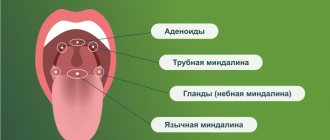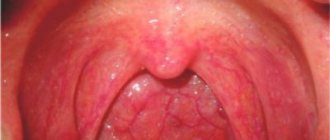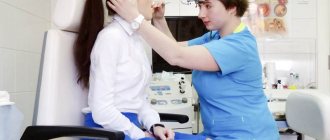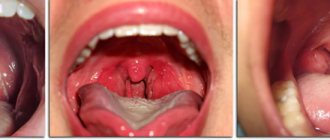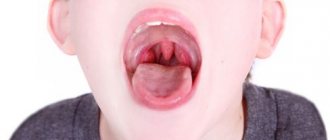Chronic tonsillitis is a process that is quite difficult to deal with, because often its signs are ignored or simply not noticed by patients, and doctors rarely pay due attention to it - until the patient himself begins to complain of feeling unwell. During exacerbations of the disease, a course of antibacterial agents is usually prescribed, and with a short “experience” of the disease, they help well. However, over time, the effectiveness of antibiotics decreases, and often those drugs that suppressed the growth of microbes during the first attacks cease to have any effect in the future. What explains this?
Symptoms:
- red, swollen tonsils with white or yellowish coating or streaks;
- a sore throat;
- difficult and/or painful to swallow;
- fever (temperature above 38.0);
- cervical lymph nodes are enlarged;
- hoarse or hoarse voice;
- headache;
- stiff neck muscles;
- abdominal pain (especially in young children).
In infants:
- drooling due to pain in swallowing;
- anxiety;
- refusal to eat
- With chronic tonsillitis, your breath may smell bad.
Treatment at home
To determine the diagnosis and begin treatment, contact your doctor. If you are diagnosed with acute tonsillitis, you must observe strict bed rest in the first days of the disease, then limit physical and psycho-emotional stress, which will help get rid of complications, among other things. The patient is given a personal plate, spoon, mug and, if possible, isolated. Prescribe non-irritating, soft foods, mainly plant-based, dairy, vitamin C, and plenty of warm drinks. Symptomatic therapy is also carried out: taking antipyretic, anti-inflammatory, painkillers.
Rinsing
Special attention should be paid to local therapy. Gargling with antiseptic solutions (Hexoral ® gargling solution) is useful for tonsillitis. The drug Hexoral ® has broad antibacterial activity, including against gram-positive microbes, is also active against the pathogenic genus of fungi Candida, and has an effect in the treatment of infections caused by Pseudomonas aeruginosa and Proteus. The antimicrobial effect of the drug is associated with the suppression of metabolism in bacteria, their oxidative reactions, without which the latter cannot exist (thiamine antagonist). At a concentration of 100 mg/ml, the drug inhibits the growth of most bacterial strains. The development of resistance to Hexoral ® is not observed. The active substance hexethidine has a mild analgesic effect on the mucous membrane of the pharynx and tonsils, can linger on it for a long time and is practically not absorbed. Therefore, it does not have a systemic effect. When using the drug Hexoral ®, regression of inflammatory changes in the pharynx may be observed5. It is recommended to use 15 ml of undiluted solution 2 times a day after meals, unless otherwise prescribed by a doctor. Before use, consult a specialist.
Rinsing is an effective method and an important component of the fight against tonsillitis, which can be successfully used in home treatment. Rinsing with a salt solution, irrigating the oropharynx with sprays with sea water, a decoction of chamomile, sage, chlorhexidine and other antiseptics help well. Rinsing with solutions at body temperature (36-37 degrees) reduces inflammation, mechanically cleanses the mucous membrane of the oropharynx from viruses, bacteria, pus, helps relieve swelling, and as a result, reduce sore throat. Rinsing is completely safe for children, pregnant women and nursing mothers.
Washing the lacunae of the tonsils with antiseptics is used for many types of both acute and chronic tonsillitis. The most common method of washing the lacunae of the tonsils is according to N.V. Belogolov. and Ermolaev V.G1. This effective procedure is performed by an otolaryngologist. Under the control of pharyngoscopy, the doctor sequentially inserts a thin cannula through each lacuna into the crypt of the tonsil, and with a syringe filled with an antiseptic, under pressure washes out everything unnecessary from the lacuna. As a rule, 2-3 crypts of the upper part of the tonsil are washed. All tonsil crypts are usually connected to each other, so the entire tonsil is washed and drained. After this, the treated mucous membrane is lubricated with Lugol’s solution, iodine, and 5% collargol. The positive effect of the procedure is achieved by mechanically flushing the lacunae from pus and restoring their drainage function. Treatment is carried out in a course of 10-15 washes, which are prescribed every other day.
Complications of tonsillitis
- Labored breathing.
- Sleep apnea (holding your breath during sleep).
- Spread of infection to the tissue near the tonsils (peritonsillitis), peritonsillar abscess - accumulation of pus behind the tonsil.
- Acute cervical lymphadenitis is inflammation of the cervical lymph nodes.
Streptococcal tonsillitis can cause complications such as:
- acute rheumatic fever, affecting the joints, heart and other organs;
- glomerulonephritis (inflammation of the kidneys, which can lead to serious consequences, including kidney failure).
Treatment with antibiotics significantly reduces the likelihood of complications after streptococcal sore throat.
Why do you need to rinse your tonsils?
The palatine tonsils are an organ of the human immune system. They are located at the very entrance to the pharynx on both sides. Outwardly, they resemble almonds. This similarity gave this organ its name. The tonsils consist of a large number of winding canals - crypts. On the surface of the tonsils there are small depressions - lacunae. It is in them that tonsillitis plugs accumulate, which are removed by washing.
Our tonsils act like a filter. They filter everything that enters the oral cavity from outside. And if infectious flora gets on the surface of the tonsils, they begin to produce lymphocytes - cells of the immune system that begin to fight the “enemy”.
If the body's defenses are not enough to cope with viruses and bacteria, an inflammatory process (chronic tonsillitis) starts in the palatine tonsils. In the gaps, pathogenic microflora is activated, the remains of bacterial activity and dead leukocytes accumulate. This entire “mixture” is compressed and turns into white-yellow plugs on the tonsils, which are noticeable upon examination and emit an unpleasant odor. These plugs do not allow inflammation to subside, so sanitation of the tonsils is an important part of the treatment of chronic tonsillitis.
Often, rinsing is the only way to preserve the tonsils and avoid their removal.
Diagnosis of tonsillitis
- For tonsillitis, the doctor will examine the child's throat, as well as his ears and nose, where there may also be inflammation.
- The doctor will examine the child's skin, since streptococcal sore throat sometimes causes a specific rash. This is what is called “scarlet fever” - it is not some kind of separate disease, but a sign of damage to the body by streptococcus.
- The doctor will feel the cervical lymph nodes - as a rule, with tonsillitis they swell.
- The doctor will feel the spleen to distinguish a sore throat from mononucleosis, which also causes swollen lymph nodes.
- The streptococcal test is a simple and accurate way to distinguish streptococcal tonsillitis from viral tonsillitis. The doctor takes a scraping from the child’s throat and within 24-48 hours the result is ready.
- In some cases, a general blood test may be needed, the results of which can also indicate the viral or bacterial nature of the disease. It is usually taken if the streptococcal test is negative, but the course of the disease leaves the doctor in doubt.
About the clinic
Euromed Clinic is a multidisciplinary family clinic in the center of St. Petersburg.
- Calling a doctor to your home
- 24/7 therapist appointment
- Tests, ultrasound, x-ray
- Whole body diagnostics
- Hospital and surgery
- Vaccination
Find out more about the clinic
Rinsing the tonsils with a syringe
This method is the most common and accessible. It will be offered to you at the local clinic. The essence of the technique is as follows: an ENT doctor, using a needle-free syringe, injects an antiseptic drug into the lacunae of the tonsils, which, together with the purulent masses from the lacunae, is washed into the patient’s oral cavity. The patient spits the solution into a special tray, and the ENT doctor repeats the procedure. Upon completion, the tonsils are lubricated with Lugol's solution.
The disadvantage of the procedure is that it is not possible to thoroughly rinse the lacunae, since the openings in the tonsils are very narrow. This rinsing helps with minor purulent accumulations.
The manipulation should be carried out by an experienced ENT doctor. Inept movements can injure the walls of the tonsils, which will only worsen the patient’s condition.
Recently, in modern ENT clinics this technique is used less and less, mainly in cases where the patient has a pronounced gag reflex.
It is much more effective to rinse the tonsils using a vacuum method using the Tonsillor apparatus.
Treatment of tonsillitis
The child should be provided with:
- peace and the opportunity to sleep as much as he wants;
- Drink plenty of fluids to relieve sore throats and prevent dehydration;
- air humidification;
- a sore throat can be relieved by both warm drinks and cold ice cream, especially popsicles;
- for a sore throat, it helps to gargle with a solution of table salt and soda - a teaspoon of salt and a small pinch of soda per 250 ml of warm water;
- Children over 4 years old can be offered lozenges for sore throats. Do not give candy to small children - they may choke;
- do not smoke when your child is sick, avoid strong odors that irritate the throat;
- A sore throat and fever can be relieved by medications containing paracetamol and ibuprofen. Don't give children aspirin; in rare cases, it can cause deadly Reye's syndrome.
Confirmed bacterial tonsillitis (usually streptococcal tonsillitis) is treated with antibiotics. It is dangerous to interrupt or stop the course because it increases the likelihood of infection spreading to the joints, heart, kidneys and other organs. Continue taking antibiotics even if your symptoms are completely gone.
Remove or treat?
Among experienced patients, there are many stories from the series: “Previously, the problem was solved simply - you just need to remove the tonsils, and life will sparkle with bright colors.” Many patients purposefully come to an ENT doctor with a request to get rid of tonsils once and for all. However, many do not understand that by removing such an important organ of the immune system, a person is deprived of a natural barrier against infection. Yes, the problem of tonsillitis will disappear, but other diseases, for example, of the respiratory tract, will take their place. Bacteria and viruses will be able to freely enter the body, causing inflammation of other human organs and systems.
To remove tonsils according to indications, you need:
- often have a sore throat (more than four times a year);
- have a history of peritonsillar abscess;
- have poor rheumatic test scores;
- diagnose complications in your heart, kidneys or joints.
If there are no direct indications for removal, you need to contact an otolaryngologist to prescribe competent complex therapy, which will significantly increase the duration of remission and reduce the number of exacerbations.
One of the most effective procedures for treating tonsillitis, which avoids removal, is washing the palatine tonsils.
Vacuum rinsing of tonsils
Modern otolaryngological offices carry out rinsing of the tonsils with Tonsilor - a special device that carries out cleaning using ultrasound and antiseptic solutions.
It quickly helps to achieve the desired result and has the following effect after use:
- anesthetic;
- antibacterial and antifungal;
- increases local immunity;
- restores normal microflora on the surface of the tonsils.
Prevention of exacerbation of chronic tonsillitis
Prevention of tonsillitis is a set of measures that protect the body from attacks by streptococci in a completely healthy body. First of all, prevention includes strengthening the immune system:
- Hardening. In order for the body to be resistant to temperature changes, it is necessary to harden. In the summer in the fresh air, in the winter you can do it in the bathroom.
- Balanced diet. The menu should include cereals, meat (preferably rabbit or beef), fish, vegetables, and fruits.
- Sports activities. It helps keep you in shape through physical exercise.
- Maintain oral hygiene, brush your teeth with toothpaste in the morning and evening, limit the amount of sweets to prevent caries and other diseases.
- Treat a sore throat in a timely manner. It is enough to consult a doctor in time and follow all his recommendations.
- After the next relapse, in order to avoid a recurrence of exacerbation, you need to visit an otolaryngologist from time to time for prevention.
Help: Proper treatment of sore throat guarantees one hundred percent protection against chronic tonsillitis.
According to statistics, washing the tonsils with Tonsillor helps achieve greater effectiveness in treating the disease compared to other methods. Some patients have reduced relapses, while others note an improvement in their overall health.
How is the procedure performed?
All rinsing methods are based on exposing the tonsils to a stream of disinfecting solution or vacuum. Cleaned tonsils are treated with medications.
Processing each tonsil takes from 30 seconds to 1.5 minutes. The time depends on the choice of type of cleaning of the lacunae and the depth of damage to the lacunae.
Important! Before the procedure, you cannot eat for 1.5-2 hours. This is due to the fact that rinsing provokes a gag reflex.
To prevent possible discomfort, the doctor treats the tonsils with a local anesthetic with lidocaine or novocaine in the form of a spray.
What is the Tonsillor device?
"Tonsillor - 3MM" is used for the conservative and surgical treatment of diseases of the ENT organs through the combined effects of ultrasound, vacuum and ozone/NO-containing medicinal substances on the affected tissues.
Ultrasound, which has healing properties, allows for anti-inflammatory and resorption therapy, pain relief, improves blood microcirculation at the site of exposure, cleans wounds of necrotic tissue and bacterial contamination and creates a drug depot at the site of the lesion. Under the influence of ultrasound, trophism, blood supply to tissues, metabolism improve, and local immunity is stimulated.
Washing tonsils at home
If you have tonsillitis, you can rinse your tonsils at home. Someone close to you can help you with this, or do everything yourself. To begin, prepare a saline or furatsilin solution and thick cotton swabs. Soak the latter well with the resulting liquid and then wash the affected lacunae with light pressure. Repeat the action several times.
Those who know the exact location of the organ can manipulate it using a syringe. The needle is then removed. To use this method, you need to have certain skills.
Contraindications to washing with hardware methods
Despite such a positive effect from hardware methods, in some cases this method cannot be used. These include:
- Retinal detachment.
- Hypertension in stage 3 or 2B.
- 1st and third trimester of pregnancy.
- Acute forms of infectious diseases.
- Oncopathology.
- Atherosclerosis of coronary or cerebral vessels.
- Active tuberculosis.
- Disorders of the autonomic nervous system.
- Pathology of the respiratory and cardiovascular systems in the stage of decompensation.
Classification B.S. Preobrazhensky
| Form of the inflammatory process | Distinctive manifestations |
| Simple (uncomplicated) form | Only local signs are present: Pus and dense plugs from it, closing the lumen of the lacunae, and the inflamed surface of the tonsils (they are loose, red, swollen). Inflamed edges of the arches of the palate (they are swollen, red, infiltrated). |
| Toxic-allergic tonsillitis 1st degree | Local manifestations of an uncomplicated form are superimposed by general symptoms of an allergic-toxic nature: Periodic low-grade fever (temperature readings up to 37.5°C). Tonsillogenic intoxication, present constantly or periodically - decreased performance, fatigue, poor appetite, general weakness, malaise, feeling of weakness throughout the body. Enlargement of the lymph nodes of the neck, their soreness. Periodically appearing joint pain. Changes in blood tests - increased leukocytes, accelerated ESR. |
| Toxic-allergic tonsillitis 2nd degree | Signs of the 1st degree are accompanied by severe manifestations of a toxic-allergic nature: Functional ECG changes. Heart pain. Heart rhythm disturbances. Long-lasting low-grade fever. Development of autoimmune complications of tonsillitis. |
Flushing with a syringe
This method can be offered in any clinic. It is considered painless and lasts about 10 minutes. The patient is seated and asked to open his mouth. A cannula is attached to the syringe. The surface of the pharynx is treated with a solution of local anesthetic. They do this to reduce discomfort during manipulation.
After this, the cannula of the syringe is inserted into the cavities of the tonsils and their contents are sucked out. This can be pus, microorganisms and their metabolic products, food debris, or liquid. After the procedure, the surface is irrigated with anti-inflammatory solutions.
Contraindications
Treatment of lacunae is not prescribed for patients with:
- exacerbation of other chronic diseases, including caries;
- cancer diagnoses;
- in the 1st and 3rd trimester of pregnancy;
- pathology of the retina;
- severe pathologies of the heart and blood vessels;
- up to 3 years of age.
For hypertension, consultation with a specialized specialist is required.
Important! It is necessary to warn the doctor about any existing individual intolerance to drugs.




